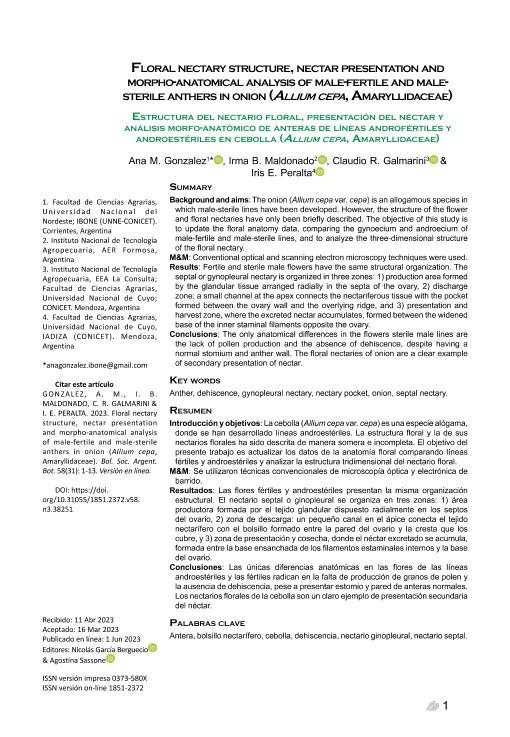Mostrar el registro sencillo del ítem
dc.contributor.author
González, Ana María

dc.contributor.author
Maldonado, Irma B.
dc.contributor.author
Galmarini, Claudio Romulo

dc.contributor.author
Peralta, Iris Edith

dc.date.available
2024-04-15T12:12:39Z
dc.date.issued
2023-06
dc.identifier.citation
González, Ana María; Maldonado, Irma B.; Galmarini, Claudio Romulo; Peralta, Iris Edith; Floral nectary structure, nectar presentation and morpho-anatomical analysis of male‐fertile and male‐sterile anthers in onion (Allium cepa, Amaryllidaceae); Sociedad Argentina de Botánica; Boletín de la Sociedad Argentina de Botánica; 58; 3; 6-2023; 477-489
dc.identifier.issn
0373-580X
dc.identifier.uri
http://hdl.handle.net/11336/232968
dc.description.abstract
Introducción y objetivos: La cebolla (Allium cepa var. cepa) es una especie alógama, donde se han desarrollado líneas androestériles. La estructura floral y la de sus nectarios florales ha sido descrita de manera somera e incompleta. El objetivo del presente trabajo es actualizar los datos de la anatomía floral comparando líneas fértiles y androestériles y analizar la estructura tridimensional del nectario floral. M&M: Se utilizaron técnicas convencionales de microscopía óptica y electrónica de barrido. Resultados: Las flores fértiles y androestériles presentan la misma organización estructural. El nectario septal o ginopleural se organiza en tres zonas: 1) área productora formada por el tejido glandular dispuesto radialmente en los septos del ovario, 2) zona de descarga: un pequeño canal en el ápice conecta el tejido nectarífero con el bolsillo formado entre la pared del ovario y la cresta que los cubre, y 3) zona de presentación y cosecha, donde el néctar excretado se acumula, formada entre la base ensanchada de los filamentos estaminales internos y la base del ovario. Conclusiones: Las únicas diferencias anatómicas en las flores de las líneas androestériles y las fértiles radican en la falta de producción de granos de polen y la ausencia de dehiscencia, pese a presentar estomio y pared de anteras normales. Los nectarios florales de la cebolla son un claro ejemplo de presentación secundaria del néctar.
dc.description.abstract
Background and aims: The onion (Allium cepa var. cepa) is an allogamous species in which male-sterile lines have been developed. However, the structure of the flower and floral nectaries have only been briefly described. The objective of this study is to update the floral anatomy data, comparing the gynoecium and androecium of male-fertile and male-sterile lines, and to analyze the three-dimensional structure of the floral nectary. M&M: Conventional optical and scanning electron microscopy techniques were used. Results: Fertile and sterile male flowers have the same structural organization. The septal or gynopleural nectary is organized in three zones: 1) production area formed by the glandular tissue arranged radially in the septa of the ovary, 2) discharge zone: a small channel at the apex connects the nectariferous tissue with the pocket formed between the ovary wall and the overlying ridge, and 3) presentation and harvest zone, where the excreted nectar accumulates, formed between the widened base of the inner staminal filaments opposite the ovary. Conclusions: The only anatomical differences in the flowers sterile male lines are the lack of pollen production and the absence of dehiscence, despite having a normal stomium and anther wall. The floral nectaries of onion are a clear example of secondary presentation of nectar.
dc.format
application/pdf
dc.language.iso
eng
dc.publisher
Sociedad Argentina de Botánica

dc.rights
info:eu-repo/semantics/openAccess
dc.rights.uri
https://creativecommons.org/licenses/by-nc-nd/2.5/ar/
dc.subject
Allium
dc.subject
cebolla
dc.subject
anatomy
dc.subject
onion
dc.subject.classification
Ciencias de las Plantas, Botánica

dc.subject.classification
Ciencias Biológicas

dc.subject.classification
CIENCIAS NATURALES Y EXACTAS

dc.title
Floral nectary structure, nectar presentation and morpho-anatomical analysis of male‐fertile and male‐sterile anthers in onion (Allium cepa, Amaryllidaceae)
dc.title
Estructura del nectario floral, presentación del néctar y análisis morfo-anatómico de anteras de líneas androfértiles y androestériles en cebolla (Allium cepa, Amaryllidaceae)
dc.type
info:eu-repo/semantics/article
dc.type
info:ar-repo/semantics/artículo
dc.type
info:eu-repo/semantics/publishedVersion
dc.date.updated
2024-04-10T12:16:41Z
dc.identifier.eissn
1851-2372
dc.journal.volume
58
dc.journal.number
3
dc.journal.pagination
477-489
dc.journal.pais
Argentina

dc.journal.ciudad
Córdoba
dc.description.fil
Fil: González, Ana María. Consejo Nacional de Investigaciones Científicas y Técnicas. Centro Científico Tecnológico Conicet - Nordeste. Instituto de Botánica del Nordeste. Universidad Nacional del Nordeste. Facultad de Ciencias Agrarias. Instituto de Botánica del Nordeste; Argentina
dc.description.fil
Fil: Maldonado, Irma B.. Instituto Nacional de Tecnología Agropecuaria; Argentina
dc.description.fil
Fil: Galmarini, Claudio Romulo. Instituto Nacional de Tecnología Agropecuaria. Centro Regional Mendoza-San Juan. Estación Experimental Agropecuaria La Consulta; Argentina. Universidad Nacional de Cuyo. Facultad de Ciencias Agrarias; Argentina. Consejo Nacional de Investigaciones Científicas y Técnicas; Argentina
dc.description.fil
Fil: Peralta, Iris Edith. Consejo Nacional de Investigaciones Científicas y Técnicas. Centro Científico Tecnológico Conicet - Mendoza. Instituto Argentino de Investigaciones de las Zonas Áridas. Provincia de Mendoza. Instituto Argentino de Investigaciones de las Zonas Áridas. Universidad Nacional de Cuyo. Instituto Argentino de Investigaciones de las Zonas Áridas; Argentina
dc.journal.title
Boletín de la Sociedad Argentina de Botánica

dc.relation.alternativeid
info:eu-repo/semantics/altIdentifier/url/https://revistas.unc.edu.ar/index.php/BSAB/article/view/38251
dc.relation.alternativeid
info:eu-repo/semantics/altIdentifier/doi/http://dx.doi.org/10.31055/1851.2372.v58.n3.38251
Archivos asociados
